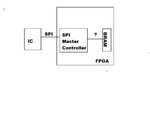sebas
Junior Member level 2
HI,
I have a design in which I used the FPGA to access an outside the FPGA IC through SPI interface.
On the FPGA I have a SPI master controller. The SPI controller has the SPI interface signals on one side (that accesses the IC's registers) and a address and data bus (sometimes Wishbone) on the other side. Now I want to put the information read by the SPI controller inside a RAM. The normal approach, for me, would be to use a microprocessor that connects to the SPI controller, on one side, and to the RAM on the other side. The microprocessor would read the SPI controller registers and write them in the RAM. Is there a more simpler approach in which the microprocessor is not needed? Maybe a controller that does the job?
Thanks!
I have a design in which I used the FPGA to access an outside the FPGA IC through SPI interface.
On the FPGA I have a SPI master controller. The SPI controller has the SPI interface signals on one side (that accesses the IC's registers) and a address and data bus (sometimes Wishbone) on the other side. Now I want to put the information read by the SPI controller inside a RAM. The normal approach, for me, would be to use a microprocessor that connects to the SPI controller, on one side, and to the RAM on the other side. The microprocessor would read the SPI controller registers and write them in the RAM. Is there a more simpler approach in which the microprocessor is not needed? Maybe a controller that does the job?
Thanks!
